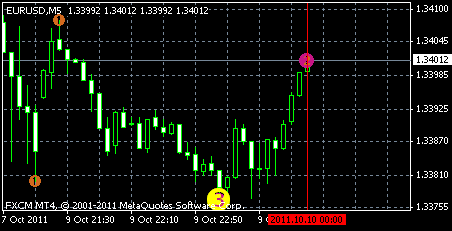Fumbling through NinjaTrader
All of the things that MetaTrader does well, NinjaTrader does very poorly. The first time that I downloaded the 42 MB installation file, NinjaTrader said that I couldn't use it because I didn't have the .NET 3.5 framework installed. That makes sense to me as a programmer. To people that do not program for a living (i.e., the people reading this blog), that error message is next to worthless. NinjaTrader ought to handle this type of issue automatically.
Once I installed the program, I tried to open a chart. Nothing happened. I messed with it for about 5 minutes until I finally gave up and decided that the program wasn't worth the effort.
I decided to try again a few months later, at which point I realized that NinjaTrader did not include a datafeed. So then I had to go through their list of 50+ vendors to figure out where I might find a decent forex feed to try using their platform. The feed that I happened to have, Interactive Brokers, required that I download a special version of their software. Naturally, I did not figure this out until I got endless error messages and had to contact NinjaTrader suppport. An hour and several handfuls of hair later, I finally was able to do what MetaTrader allows me to do in seconds - look at a forex chart.
My Windows XP machine with 2 GB RAM, which is pretty typical of your average software user, takes about 20 seconds to load NinjaTrader. I have the nasty habit of closing and opening applications repeatedly. It gets on my nerves when I close NinjaTrader because it takes so long to get it back up again. I would consider leaving the application open, but I usually have 5-6 windows open within their platform. The taskbar always looks so cluttered. Call me crazy, but I find it very difficult to work on the computer with so many window tabs showing at the same time. It feels like there is too much going on visually.
Whenever you have a question about MetaTrader, you simply pick up the phone and call any MetaTrader broker. They answer your question immediately. NinjaTrader, in spite of its excellent online support, largely takes the help yourself approach. You can figure out most problems eventually, but it requires digging through forums and reading a few articles before you stumble upon the one with the answer. That type of self-help approach requires patience. Most people, especially us Americans that expect answers on the spot, are not blessed with that particular virtue.
Products and Add Ons
MetaTrader is like Google Android and NinjaTrader is like Apple. MetaQuotes takes the Android style, hands-off approach. Anything that does not interfere with the MetaTrader itself is allowed. "Allow" isn't even the right word. MetaTrader is entirely removed from the process. The result is there are thousands of products available for sale that work exclusiely in MetaTrader. It's an accidental ecosystem for trading products that relates directly to the approach so prevalent in social media and mobile phones.
NinjaTrader takes the Apple, big brother approach; all products are screened and vetted. This does come with some advantages. You're a lot less likely to buy a total piece of garbage for NinjaTrader than you are for MetaTrader. That said, the centralized also stifles the products on offer. Maybe it's just because I'm Texan and resent anything that feels like authority making choices for me, but I think you see a lot more life and innovation when the people selling a related a product don't have to ask permission to do so.
What does Ninjatrader do, anyway?
You need to take a week's worth of online training to really get a sense for how to use the product. NinjaTrader, for some odd reason, does not offer YouTube videos or any friendly beginners guides to get up and running. They require that you attend online webinars, which are always scheduled in the middle of the work day, in order to thoroughly learn each of the product's main features.
When you open the software, it's not at all apparent what exactly it's supposed to do. Is it an automated trading platform? Is it a charting platform? Is it a tool for active traders? NinjaTrader does all of the above, but my opinion is that the software itself does a terrible job making this clear. Little things like a first-time walk after downloading through would help traders get over the steep learning curve and give the product a chance.
I actually love NinjaTrader, but it nearly takes a graduate degree to figure out how to use it. That's the only reason that I'm so hesistant to recommend it to my MetaTrader programming clients. Once you figure out how to use the tools, they are incredibly powerful. The built in trading analytics eliminate the need for MetaTrader related sites like MyFXBook and MT4Stats for viewing and studying my daily performance. Comparing MetaTrader and NinjaTrader in the backtester is not even worth doing: NinjaTrader is infinitely superior. It's too bad that NinjaTrader gets in its own way.
The features that NinjaTrader offers should make it way more popular than MetaTrader. I just don't see that happening any time soon with how long it takes to learn the software.



